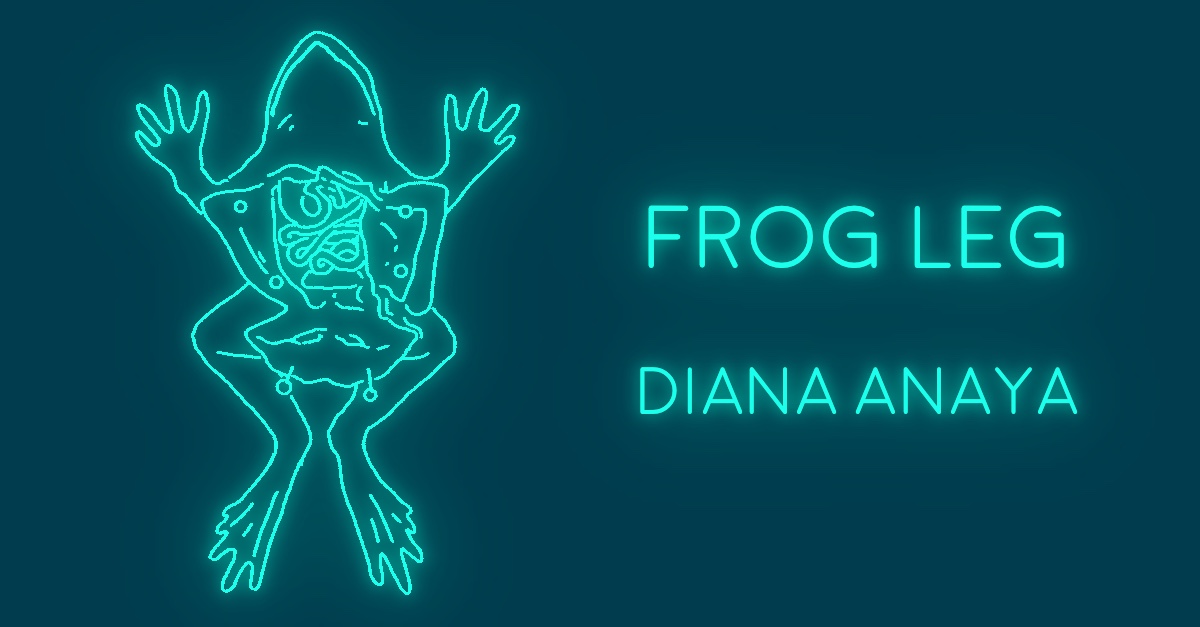Frogs aren’t too different from humans. They have the same bits as us – ears, eyes, mouth. Front legs, the equivalent of our arms, and hind legs. Muscles, organs, skin, and bones. They have a liver and a pancreas and a heart, only one chamber short of ours. Frogs are thought to have a simplified version of our anatomy, which makes them all the more reasonable subjects for high school dissections. For shrieking but curious teenagers to slice open with their tiny scalpels and hold the skin apart, pinch and pull and pluck the organs, cold, chemical-bathed miniatures of ours, and then place them on a tray to label and discuss.
Whenever my mother had to explain my leg to someone, she always said in her thick Cuban accent, “Like frog leg.”
There was definitely something amphibian about the way my legs curved, bowed outward. Two-years-old, I waddled around the apartment with my bent-out legs, incapable of standing too long without pain. But in the pool I was all grace, my toes touching as they swept water in and out, rippling vortex rings.
A study of the genome of the western-clawed frog found it contained eighty percent of human genes known to be associated with diseases. Perhaps Blount disease, my rare growth disorder in which the tibia grows out rapidly while the fibula gets compressed, should be reexamined or reclassified altogether. With a human brain and folded legs, I could be the missing genetic link between human and frog, homo anura. My genetic deformity could be a simple hiccup of DNA, creating a frog human cousin of the modern human. Instead of corrective boots and braces, maybe the real solution is to set us loose, drop us in a pond or a lake, and let us kick off.
Or maybe I was just part of a regressive gene pool, still tapping into vestigial structures of gills and pinky toes and fused bones, except my bones refused to fuse and so the tibia and fibula fought for dominance, the tibia pushed to the periphery while the fibula holds its ground, planting itself straight down to the ankle.
Since 1937, when American pediatric surgeon Walter Blount first wrote about this condition, little research had been done to find out what causes Blount Disease or develop new ways to treat it. Sometimes it’s due to obesity, sometimes early walking, and sometimes it’s genetic. Sometimes it’s a little bit of everything. But it always ends in surgery: procedure after procedure of cutting the leg open, moving the bone back into place, only to find it years later poking out again, rebellious. All just bandages until the bone stops growing. Or the other approach – years of metal rods thrusting out of the skin, turning dials daily, weekly, monthly, shifting the bone back into place every time it nudges out.
Yale cardiology researchers found that many genes that lead to childhood heart disease could be identified, diagnosed, and treated through the study of frog hearts. Scientists hunched over little frog bodies, the same formaldehyde-soaked corpses they ship off to schools. Or maybe live frogs, whose skin was peeled back so they could stare directly into their fast beating hearts. I wonder if the same could be done for my disease; if they could snip open the legs and pluck out the bent, fused bones, crack into the marrow and dig out the cure.
Touch it –
bow curve
of bone,
crescent
moon shining
between fingers
you drag
along new,
white flesh.
Press your
palm hard
and push.
Resist it:
la niña
que llora
en el
cuarto oscuro.
That girl
doesn’t exist
unless you
let her.
Close your
eyes and
see it.
Warm, straight
legs that
can run
for miles,
taut like
drawn strings.
One day
you will
be so
much more
than normal.
One day
your feet
won’t ever touch
the ground.

